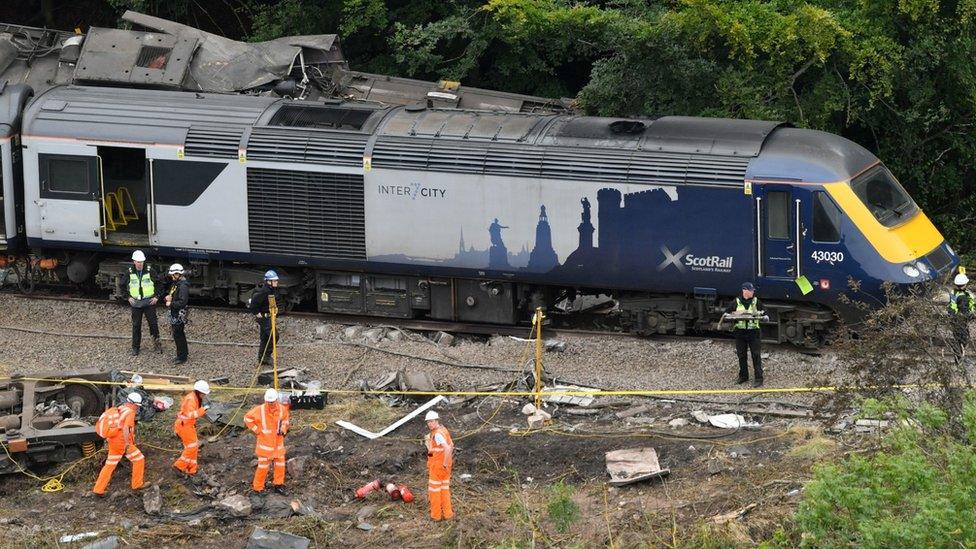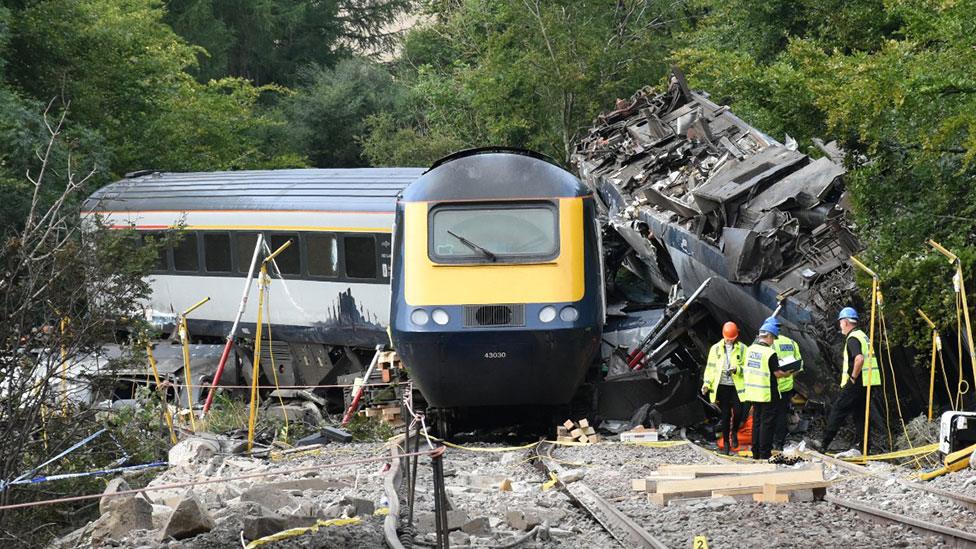Network Rail admits failings caused deaths in Stonehaven crash
- Published

Network Rail has admitted a series of failings which led to the death of three people in a train derailment near Stonehaven in 2020.
The company pleaded guilty to criminal charges at the High Court in Aberdeen.
Three people died and six were injured when a train struck a landslide at Carmont after heavy rain.
Network Rail admitted failing to impose a speed restriction, warn the driver that part of the track was unsafe, or ask him to reduce his speed.
It also admitted a number of failures over the maintenance and inspection of drainage in the area, and in adverse and extreme weather planning.
Driver Brett McCullough, 45, conductor Donald Dinnie, 58, and passenger Christopher Stuchbury, 62, died when the train derailed on 12 August 2020.
Mr Stuchbury had intended to board an earlier train which was cancelled so he boarded the train which ultimately derailed instead as he could change at Dundee.
His wife said the date of the fatal crash had been their wedding anniversary, and her husband had been travelling to one last work trip before he retired. She said they had been robbed of their future together.

Donald Dinnie, Christopher Stuchbury and Brett McCullough died in the crash
Six other people were injured when the 06:38 Aberdeen to Glasgow service hit washed-out debris at Carmont, south of Stonehaven in Aberdeenshire.
A drainage system in the area had been incorrectly installed by Carillion, which has since gone into liquidation.
The train had been returning towards Aberdeen at the time because the railway was blocked further down the line.
A Rail Accident Investigation Branch report, external said the train derailed because it struck debris that had washed out of a drainage trench.
The report made 20 recommendations to improve rail safety, many of which were directed at Network Rail.
Almost a month's rain had fallen in the area between 06:00 and 09:00 on the day of the crash, which happened at 09:37.
Advocate depute Alex Prentice KC, prosecuting, said the derailment happened after a period of extreme torrential rainfall which had led both Aberdeen City Council and Aberdeenshire Council to declare a major emergency.
He said the weather on the day of the accident was "exceptional", with the Aberdeen station controller describing the rain as "beyond biblical".

The derailment happened near Stonehaven on 12 August last year
The train had stopped for two-and-a-half hours because of a landslip before being instructed to return north so passengers could disembark.
Mr McCullough had been told to proceed at normal speed, and the train was travelling at about 73mph - below the limit of 75mph.
The prosecutor told the High Court in Aberdeen: "Despite his efforts to slow the train using the emergency brake, the driver of the train was unable to stop prior to the debris on the track.
"The train struck the debris, derailed and collided with a bridge parapet. This caused the train to veer of the bridge and down the steep embankment below the bridge."

The train hit debris in heavy rain
Mr Prentice said a recording of the driver showed he queried with a signaller if any reduced speed was needed to return north. He was told everything was fine for just normal speed.
When the emergency brake was applied there was insufficient time - 3.5 seconds of travel time - for it to have any significant effect and avoid the debris.
The prosecutor added a multi-agency investigation found the rail operator had not properly inspected the drainage system following its installation and had failed to properly train staff to analyse weather forecasts.
The investigation also found Network Rail, which owns and repairs the railway infrastructure across the UK, did not ensure as far as was reasonably practicable that drainage near Carmont was constructed properly and in accordance with design drawings.
A spokesperson for the rail operator described the fatal event as a "terrible day for our railway" adding it is clear there was fundamental lessons to be learnt.
Following the derailment, Network Rail inspected all similar locations across Britain and carried out a full survey of all types of trackside drainage on Scotland's railway in the wake of the crash.
It also made safety changes including how it manages the running of train services during severe weather.
It has also introduced a new team of weather experts in its control room to provide round-the-clock, real-time analysis on how the weather may affect the railway.
'Forever missed'
All three of the men who died were said to have suffered numerous non-survivable blunt force injuries, the most significant of which were to the head, with death likely immediate.
Mr McCullough, the driver of the train, was found on a lower embankment at the crash site. He was pronounced dead at 10:40. His family said he will be "forever missed".
The court heard the conductor, Mr Dinnie, had over 30 years of railway experience. His body was found in the doorway of one of the train carriages. His daughters paid tribute to his "infectious smile".
Mr Stuchbury, a tug master and captain in the merchant navy, is thought to have been thrown clear of the carriage he had been travelling on. He was pronounced dead at 11:00.
Statements from the six injured passengers described physical, mental and financial scars they have been left with.
The case at the High Court in Aberdeen continues on Friday.
Related topics
- Published6 September 2023

- Published10 March 2022
